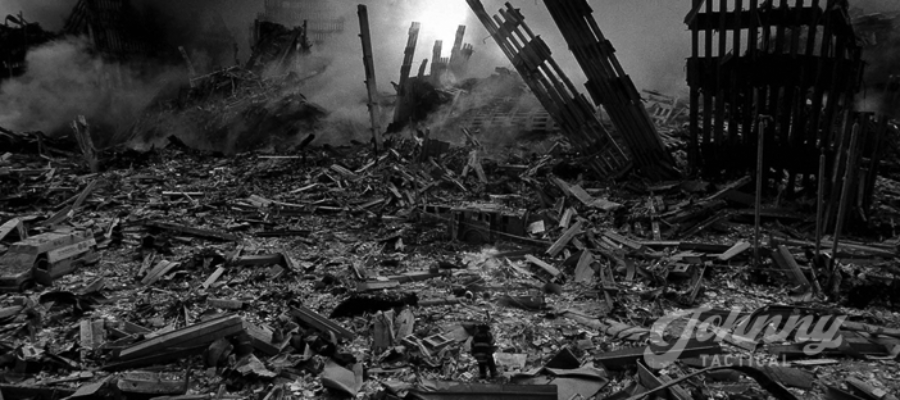After a loss something inside us wants things to go back to the way things were. Back to the familiar. We spend inordinate amounts of time and energy being disappointed in that regard, of doing the same thing over and over expecting different results. But you can’t go back.
The Twin Towers came down on that Tuesday morning, due to no fault of their own. They came down because of what was done to them. When the dust and smoke finally cleared what was left of the towers was an unrecognizable tangled pile of cement and metal and glass and drywall and carpet and cubicles and desks and chairs and picture frames and files and papers. It was what the towers had been made of, but it was no longer the towers. They were gone.
But the time would come to make something new.
Build Again
In order to build on ground zero — not rebuild, there is a difference — some things had to happen. The loss had to be grieved; that itself is a process. Then, with a lot of help, all the things lying in a pile that used to be the Twin Towers had to be excavated. The old things, the debris, the remains, had to be removed all the way down to the very foundations. Architects and engineers developed plans and drawings of what to make next. New materials were brought in, work followed, and over time a new building rose from the ashes of incredible loss.
Had the architects planned to not excavate the site, but to sort all the different materials, and then tried to put the buildings back together by reusing the broken pieces, you’d think they were crazy. It doesn’t take an engineering degree to understand that using bent and broken pieces to construct a building just wouldn’t work. There’s no way it would last and it couldn’t possibly be relied upon. It would be ugly and unstable and inevitably come down again — the next time, on its own.
And yet, we often use that same logic in our own lives.
The Thing About Grief
When we lose a spouse, a job, get divorced, crash a car, declare bankruptcy, lose our spot on a team we loved, violate someone’s trust, or get diagnosed with a condition or a disease, our first instinct is to want to go back to the way things were. We hope and wish and try to rebuild by putting the broken pieces back together. But they don’t really fit anymore, and it either doesn’t work at all or it doesn’t work for long. It crumbles again and we’re right back where we started.
Best-selling author Dr. John Delony in his book Own Your Past Change Your Future says that grief is a gift. He describes grief as the “gap between what you hoped or expected would happen and what actually did happen. The space between what you wanted versus what you received.”¹
Grief recognizes a loss, but more than that, recognizes the finality of the loss. Grief acknowledges reality — that you can’t go back to the way it was or to the way you were. Grief shines light on that smoldering heap in front of you that used to be that thing that was so important to you, but is no more. The pieces are there, but the thing you had is not.
Before and After
After grief comes the real work. The work of clearing the mess away, down to the very foundation, and making something new, because you can’t rebuild the old. You can, however, create a plan, gather new materials, and then put them together piece by piece and raise something good from the dust and ash.
If you’ve been on earth for any amount of time, you’ve experienced loss, whether large or small. It’s important to grieve those losses and then set them down. Your life after experiencing loss will be different. Your after will be different than your before. You can’t go back. But you can build something new, something stronger, something lasting. Stop trying to get back to the way things were and start the process of clearing the rubble to make room for building something new.
I’m no expert on this, believe me, I’ve just been through some stuff and, like you, I’m trying to figure it all out. So, when I come across a thought or an idea that I find helpful, I feel compelled to share it. I hope you find your way from the before to the after and let go of the way things were.
__________________________
- Are you trying to go back to the way things were?
- Do you feel caught in a vicious cycle?
- How can you begin the clean up and move toward building something new?
- Who can you go to for help and guidance?
__________________________
Thanks for reading! Do you have a story that you think we could learn from and that you’d like to share with Johnny Tactical nation? Fill out the contact form and include your name, rank, and department, or email it to [email protected] and follow these guidelines:
– It must be a firsthand account
– True
– Have a lesson, principle, or tactic to apply
– Cleaned of names, dates, and places
– Include your call sign
If your story is selected and published in our blog you’ll get the credit using your call sign and we’ll send you a free Live Tactical t-shirt!
__________________________
¹Dr. John Delony, Own Your Past Change Your Future: A Not-So-Complicated Approach to Relationships, Mental Health, and Wellness (Franklin: Ramsey Press, 2022), 151.



Leave a Reply
Your email is safe with us.
You must be logged in to post a comment.